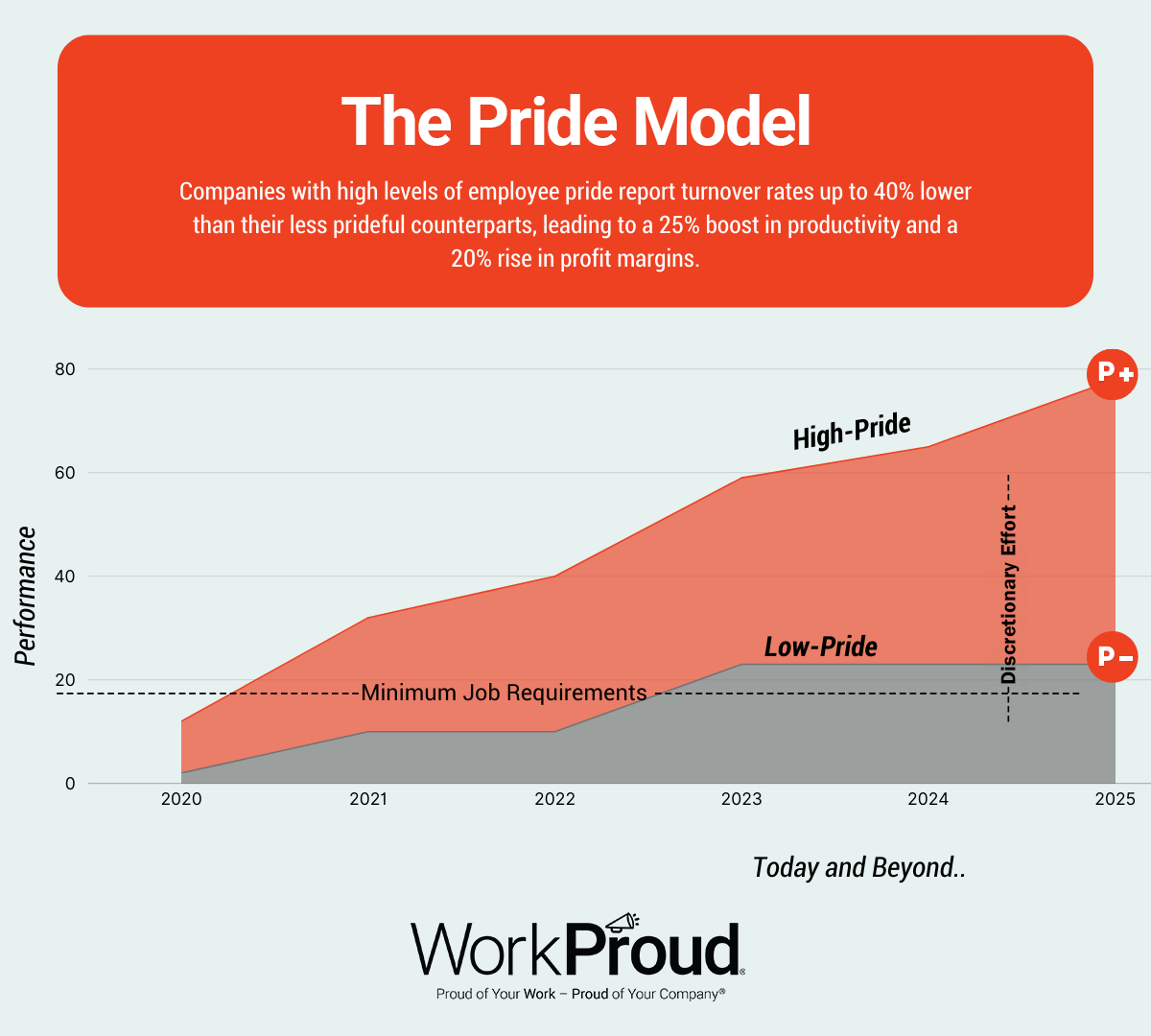An insightful article by WorkProud CEO, Michael Levy

In today’s competitive business landscape, the difference between a good company and a great company often hinges on the level of discretionary effort employees are willing to invest.
While traditional models emphasize a compliance-based “have-to-do” approach, at WorkProud, we advocate for a “want-to-do” model – inspired by employee pride. This model isn’t merely theoretical; independent research and data reveals that companies where employees indicate high levels of individual work and company pride show turnover rates 40% lower than their less prideful counterparts. This decrease in turnover is accompanied by a 25% boost in productivity and a 20% rise in profit margins.

Pride in the workplace transforms the employee experience, fostering an environment where discretionary effort thrives.
This intrinsic motivation propels employees to exceed their basic job requirements, innovate, and actively contribute to organizational success. By cultivating pride, companies not only enhance engagement but also drive higher performance and resilience. The WorkProud study demonstrates that leveraging pride as a motivator is key to unlocking the full potential of your workforce, making it a cornerstone of a high-performance workplace and a fundamental component of any robust total rewards strategy.
The “have-to-do” (not sure what this is…?? Maybe just needs labels on the chart ?) curve represents the minimum effort required for employees to keep their jobs. It includes tasks that are clearly defined in job descriptions, performance metrics, and standard operating procedures. Employees on this curve are often motivated by fear of repercussions such as losing their job or facing disciplinary actions. They do what is necessary to avoid negative consequences but rarely go beyond.
This curve is characterized by compliance. While employees meet their basic responsibilities, they are unlikely to innovate, show initiative, or engage deeply with their work. The “have-to-do” mindset can lead to a culture of minimal effort and disengagement where the organization struggles to achieve its full potential.
On the other hand, the “want-to-do” curve is where the magic happens. This curve represents the additional effort employees willingly invest because they are genuinely engaged and motivated. They go above and beyond their job descriptions, driven by intrinsic factors such as personal satisfaction, a sense of purpose, pride in the company and pride in their work.
Employees on the “want-to-do” curve are proactive, innovative, and committed. They don’t just complete tasks; they seek out ways to improve processes, contribute to the company’s success, and help their colleagues. This discretionary effort is the secret ingredient to creating a high-performance workplace.
The challenge for leaders is to create an environment where discretionary effort thrives. Here’s how:
Pride is a powerful motivator. When employees feel proud of their work and their company, they are more likely to invest discretionary effort. At WorkProud, we have seen how cultivating a sense of pride can transform a workplace. It’s about celebrating both big and small achievements and making employees feel valued every day. As discussed in the WorkProud study, genuine recognition goes beyond mere participation trophies—it’s about meaningful appreciation that fosters engagement.
People want to know that their work matters. Connecting daily tasks to the larger mission of the company gives employees a sense of purpose. When they understand how their work contributes to the bigger picture, they are more likely to go the extra mile. This ties into the storytelling aspect highlighted in our previous discussions—crafting a compelling narrative around the company’s mission can greatly enhance employee motivation.
Trusting employees to make decisions and giving them opportunities to grow fosters a sense of ownership. When employees feel they have control over their work and career path, they are more inclined to invest discretionary effort. This approach is a cornerstone of the WorkProud philosophy where we strive to make employees feel “Proud of Your Work, Proud of Your Company.”
A supportive, inclusive, and positive work environment encourages employees to put in extra effort. This includes promoting work-life balance, ensuring psychological safety, and fostering a sense of community. As previously mentioned, the culture we build directly impacts how much discretionary effort our teams are willing to put in.
Leadership sets the tone. Leaders who demonstrate commitment, passion, and discretionary effort themselves inspire their teams to do the same. It’s about walking the talk and showing employees what it looks like to go above and beyond. In my own journey with WorkProud, leading by example has always been a pivotal aspect of our success.

For Chief Human Resource Officers (CHROs) and HR professionals, understanding and leveraging the discretionary effort model is not just beneficial—it’s essential. The role of HR is evolving from traditional administrative functions to becoming strategic partners in driving organizational success. In this context, fostering a “want-to-do” culture is critical.
CHROs and HR leaders are tasked with cultivating an engaged and productive workforce. The “have-to-do” model, where employees do the bare minimum to avoid negative consequences, leads to high turnover rates, low employee morale, and stagnant productivity. Conversely, the “want-to-do” model promotes a culture of pride and engagement, driving higher levels of innovation and performance. By focusing on this model, HR leaders can create a work environment where employees are motivated to contribute their best, leading to sustained organizational success.
Internal communications teams play a pivotal role in shaping the workplace culture and keeping employees informed and motivated. Traditional top-down communication strategies often fail to resonate with today’s workforce. Instead, fostering a culture where employees feel genuinely proud and valued requires ongoing, meaningful, two-way communication. When employees are engaged in this manner, they are more likely to invest discretionary effort, going above and beyond their basic job requirements.
In a high-performance workplace, HR and internal communications must work together to promote a culture that values discretionary effort. This involves not only recognizing and rewarding employees but also creating opportunities for them to grow and take ownership of their work. By shifting efforts towards the “want-to-do” model, organizations can build a more resilient and adaptable workforce. This is particularly important in times of change or crisis, where the discretionary effort of employees can make the difference between merely surviving and truly thriving.
Understanding and leveraging the discretionary effort model is crucial for creating a high-performance workplace. By shifting from a “have-to-do” to a “want-to-do” mindset, organizations can unlock the full potential of their employees. This shift is particularly significant for CHROs, HR professionals, and internal communications teams. By fostering a culture of pride and engagement, these leaders can drive higher levels of innovation, productivity, and resilience within their organizations.
For HR leaders, focusing on the “want-to-do” model means creating an environment where employees feel genuinely valued and motivated to contribute their best. This involves strategic initiatives that go beyond traditional recognition programs, emphasizing continuous, meaningful engagement and growth opportunities. Internal communications teams play a critical role in this transformation by fostering two-way communication that resonates with and motivates the modern workforce.
At WorkProud, we are dedicated to helping companies create environments where discretionary effort thrives. We believe in celebrating both big and small achievements, making employees feel “Proud of Your Work, Proud of Your Company.” By focusing on pride, purpose, autonomy, a positive environment, and leading by example, organizations can inspire employees to go beyond the basics and achieve extraordinary results.
Remember, it’s not just about what employees have to do; it’s about inspiring them to want to do their best. That’s the true measure of a high-performance workplace and the path to sustained organizational success. If you’d like to learn more about WorkProud and employee recognition, click here to sign up for a free demo.
WorkProud is committed to helping its clients create a unified approach to the employee experience by helping them build cultures of workplace pride. Trusted by millions of users at some of the world’s most recognized employer brands, WorkProud delivers a comprehensive approach to building company cultures that inspire people to be Proud of their Work and Proud of their Company.
Here you will find insights curated for leadership seeking in-depth industry knowledge. Explore comprehensive studies, helpful guides, and expert white papers.
*By selecting “VIEW RESOURCES,” you agree to WorkProud’s Privacy Policy. You may unsubscribe from our emails at any time. Please note when unsubscribing: it may take up to 10 business days for your request to take effect.